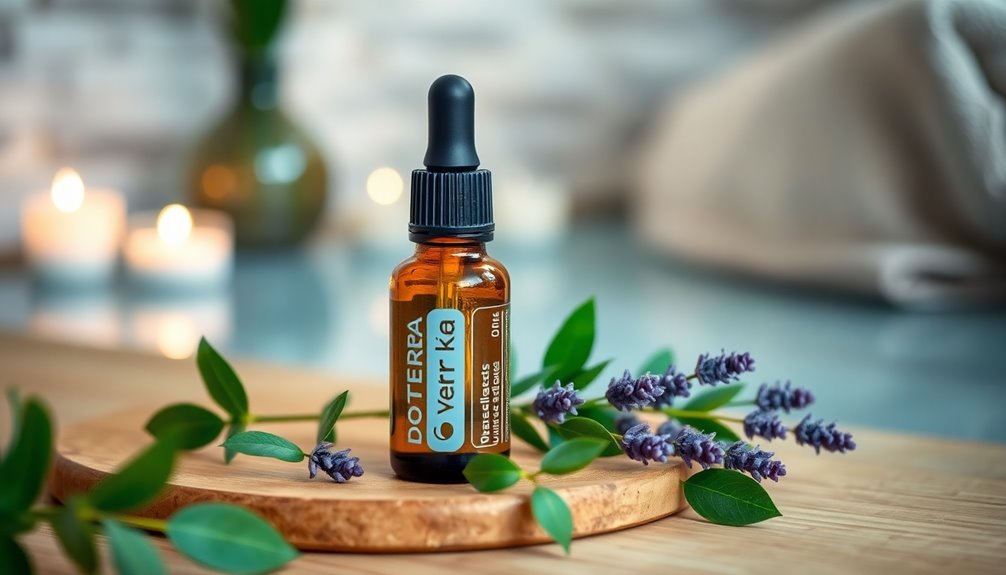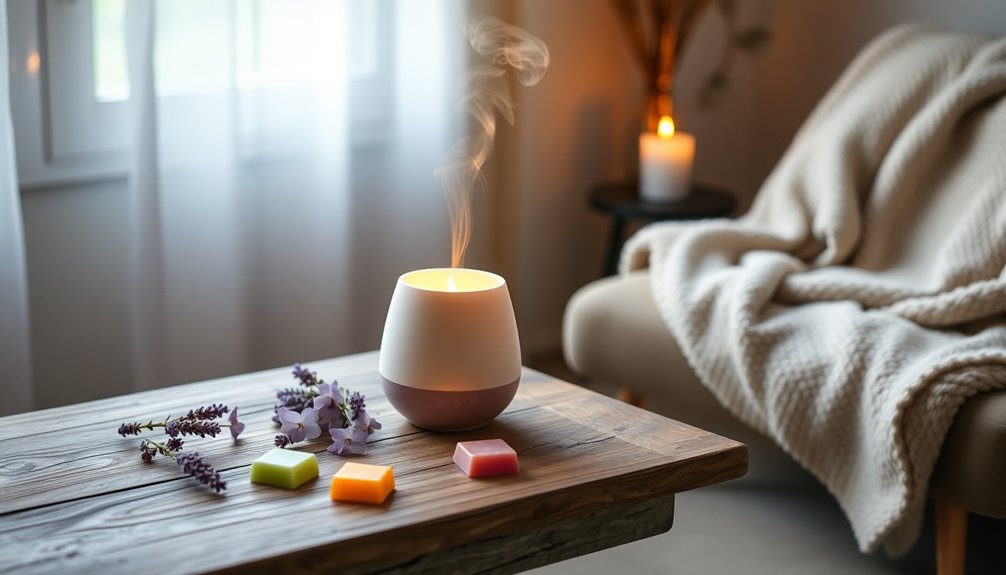Yes, ginger is indeed an aromatic plant. Its fresh root has a spicy fragrance that can uplift a dish's flavor. When you slice or grate ginger, it releases volatile compounds that enhance its distinctive aroma. Cooking transforms its chemical makeup, turning gingerol into zingerone, which produces a sweet, warm scent reminiscent of gingerbread. This versatility means ginger can enhance both sweet and savory dishes, from stir-fries to baked goods. So, whether you're using it in a curry or making ginger tea, its aromatic qualities are sure to shine. You'll discover even more fascinating aspects of ginger's properties soon.
Key Takeaways
- Ginger has a warm, spicy aroma due to volatile compounds like gingerol and zingiberene, enhancing its aromatic profile in culinary uses.
- Fresh ginger releases citrus and floral undertones when sliced or grated, contributing to its fragrant character.
- Cooking ginger transforms its flavor profile, converting gingerol into zingerone, which adds a sweeter, more aromatic quality.
- The heat applied to ginger elevates its aromatic properties, making it suitable for various dishes and desserts.
- Overall, ginger is recognized for its aromatic qualities, making it a popular ingredient in both sweet and savory cuisines.
Botanical Characteristics of Ginger
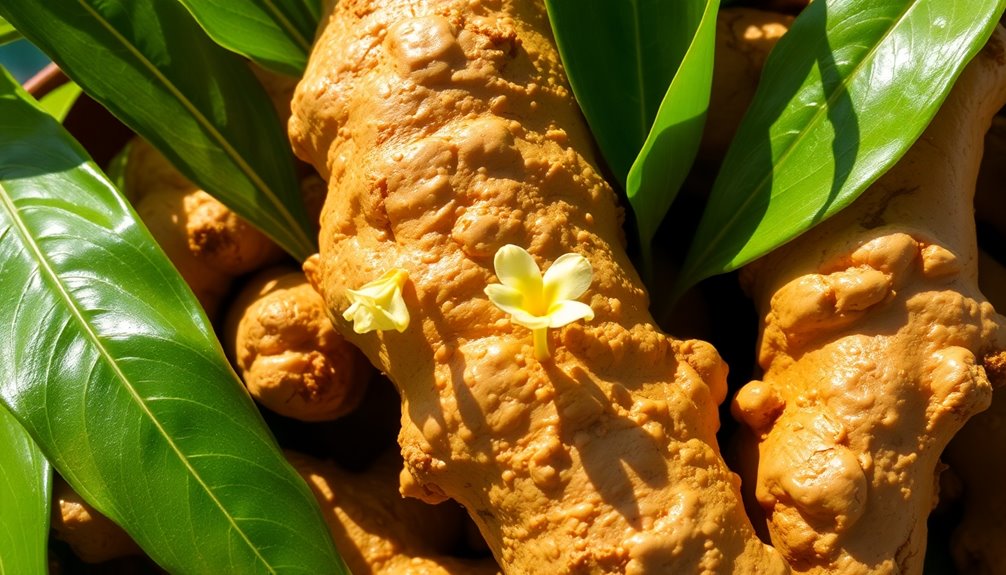
Ginger, scientifically known as Zingiber officinale, is a fascinating tropical perennial herb that thrives in warm, humid environments. This plant can grow up to 1.5 meters tall and features lanceolate, glabrous leaves.
Its distinctive rhizome and fibrous root system are key characteristics that set it apart. Native to Southeast Asia, ginger is now cultivated in various tropical and subtropical regions globally.
Belonging to the Zingiberaceae family, it shares this lineage with other popular spices like turmeric and cardamom.
What truly captivates you is its warm, spicy, and subtly sweet aroma, which is attributed to compounds like gingerol and zingiberene.
Understanding these botanical traits helps you appreciate ginger's unique qualities in the culinary world.
Historical Significance of Ginger

For over 5,000 years, this remarkable rhizome has played a crucial role in various cultures, particularly in India and China, where it was prized not just for its flavor but also for its medicinal properties.
Ginger's long history as a spice is evident in its popularity during the 13th and 14th centuries in Europe, where it became the second most sought-after spice after pepper. King Henry VIII even believed ginger could ward off the plague, showcasing its esteemed status as a medicinal remedy.
The first documented reference to ginger, found in "Hortus Indicus Malabaricus," reflects its early use and cultivation. Additionally, botanists recognized the Zingiber genus in 1790, solidifying ginger's importance in botanical classification.
Culinary Uses of Ginger

Throughout history, this remarkable rhizome hasn't only served medicinal purposes but has also become a staple in kitchens around the world.
You'll find ginger enhancing the flavor and aroma of countless dishes, especially in Asian cuisine. Here are some culinary uses of ginger you might enjoy:
- Curries: Adds a warm, spicy flavor.
- Stir-fries: Elevates the dish with its fresh aroma.
- Beverages: Ginger beer and ginger ale provide a distinct kick.
- Baking: Cakes and biscuits gain depth from its sweetness.
Whether you're using fresh or dried ginger, its versatility makes it a must-have ingredient.
Ginger's unique flavor profile can transform everyday meals into something truly special!
Aromatic Properties of Ginger

Aromatic properties play an essential role in how you experience ginger in both cooking and therapeutic contexts. Fresh ginger root is packed with dominant spicy notes from compounds like gingerol and zingiberene, which contribute to its unique aroma.
When you slice or grate ginger, it releases highly volatile aromatic ingredients, enhancing its scent in your dishes. You might notice hints of citrus and floral undertones that add depth to its fragrance. The warm, spicy aroma of ginger often evokes feelings of comfort and liveliness, making it a popular choice in aromatherapy.
Notably, when you cook ginger, its aromatic profile changes; heating transforms gingerol into zingerone, resulting in a sweeter aroma that complements various culinary creations.
Health Benefits of Ginger
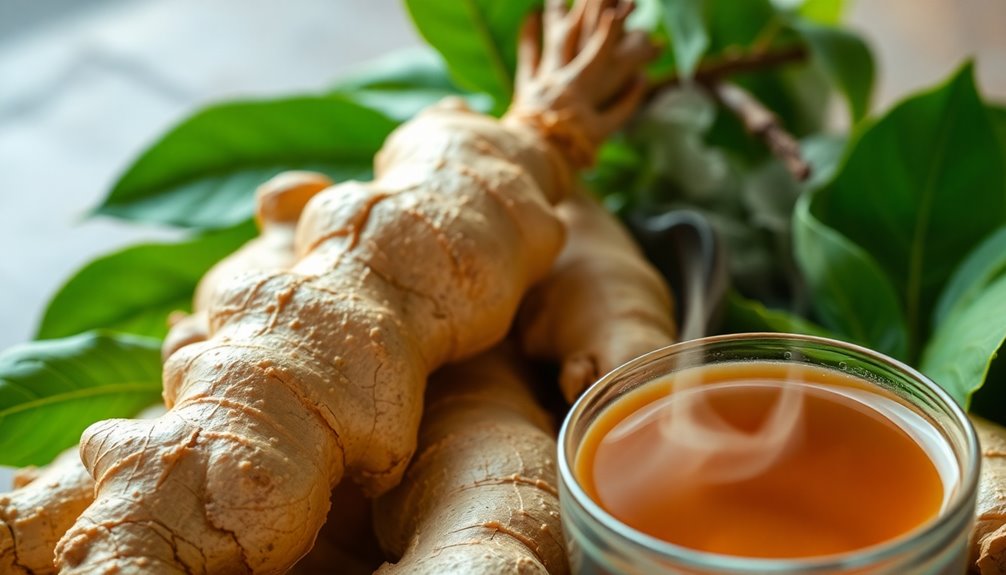
Ginger's health benefits are impressive, especially when it comes to its anti-inflammatory properties, which can help ease pain.
If you're struggling with nausea, whether from travel or pregnancy, ginger can be a natural remedy.
Plus, it acts as a digestive aid, making it a great addition to your wellness routine.
Anti-inflammatory Properties
While you might think of ginger primarily as a flavorful spice, it also boasts impressive anti-inflammatory properties that can enhance your health. These properties come from bioactive compounds like gingerol and shogaol, which help reduce inflammation in your body.
Here are some benefits you can enjoy:
- Alleviates pain from osteoarthritis and rheumatoid arthritis.
- Lowers markers of inflammation, such as C-reactive protein (CRP).
- Supports muscle recovery by combating soreness.
- Improves overall inflammatory response, reducing chronic disease risk.
Incorporating ginger into your diet, whether as a spice or in its essential oil form, can greatly contribute to better health outcomes.
Digestive Aid
If you're looking for a natural way to support your digestive health, ginger might just be the answer. Its warming properties help soothe your stomach, making it easier to digest food.
The bioactive compound gingerol stimulates saliva and bile production, enhancing overall digestion. You'll appreciate how ginger's flavor and aroma can elevate your meals while also alleviating symptoms of indigestion and bloating.
Research shows it may even improve gastric emptying, allowing for faster digestion and better nutrient absorption. Recognized by the World Health Organization for its therapeutic benefits, ginger is a reliable choice for promoting gastrointestinal health.
Incorporating ginger into your routine could provide the relief you need from gastrointestinal discomfort.
Nausea Relief
For anyone struggling with nausea, ginger offers a potent natural solution that's been celebrated for centuries. This aromatic spice can provide effective nausea relief in various situations, including:
- Motion sickness – It helps ease queasiness during travel.
- Morning sickness – Pregnant women often find relief from nausea episodes.
- Postoperative recovery – Ginger can soothe nausea after surgery.
- Chemotherapy – Many patients report reduced nausea when consuming ginger supplements.
The active compounds in ginger, like gingerol and shogaol, interact with your gastrointestinal system, promoting better digestion and alleviating nausea. Additionally, ginger may enhance cardiovascular fitness through its anti-inflammatory properties, supporting overall health during recovery.
Chemical Composition of Ginger

Ginger's chemical composition is a fascinating blend of compounds that contribute to its unique flavor and aroma. One of the key players is zingiberene, making up about 30% of ginger's essential oil and responsible for its distinctive aromatic quality.
Other significant compounds like ß-sesquiphelandrene and ar-curucumene further enhance ginger's fragrance. The pungency you associate with ginger comes primarily from gingerols, which are chemically related to the spiciness found in capsaicin and piperine.
This unique chemical structure of gingerol not only contributes to ginger's spicy characteristics but also makes it a versatile aromatic ingredient in various dishes. When you cook ginger, gingerol transforms into zingerone, altering its flavor profile and creating a sweeter aroma.
Transformation Through Cooking
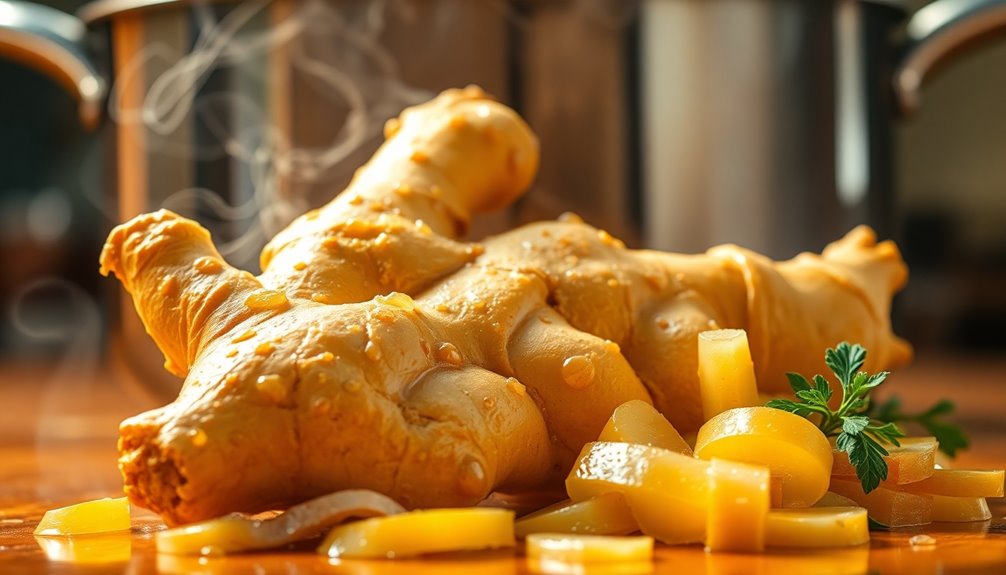
When you cook ginger, you trigger a fascinating transformation that changes its chemical composition.
The heat converts gingerol into zingerone, softening its pungency and enhancing its aroma.
This shift not only alters the flavor profile but also opens up new culinary possibilities for this beloved spice.
Chemical Changes During Cooking
As you cook ginger, a fascinating transformation occurs that enhances its flavor profile.
These chemical changes during cooking markedly alter its spiciness and aroma, making it a versatile flavor base in your dishes. Here's what happens:
- Gingerol converts to zingerone, creating a sweeter aroma.
- The pungent characteristics soften, making ginger milder.
- Cooking can produce shogaols, which are spicier than fresh gingerol.
- These transformations enhance ginger's usability in both savory and sweet dishes.
These changes not only elevate the taste but also open up new culinary possibilities.
Flavor Profile Alterations
Cooking ginger not only transforms its taste but also enhances its aromatic qualities, making it a staple in many kitchens. Through the cooking process, ginger undergoes flavor profile alterations as gingerol converts into zingerone, resulting in a sweeter, less pungent flavor. This transformation softens ginger's sharpness, creating a balanced, aromatic addition to various dishes. Zingerone imparts a warm, sweet aroma reminiscent of gingerbread, enriching your culinary experience. The cooking method you choose can profoundly influence ginger's intensity, with longer cooking times yielding a more subdued taste.
| Cooking Method | Flavor Profile Change |
|---|---|
| Boiling | Milder, softer flavor |
| Sautéing | Balanced, aromatic |
| Baking | Sweet, warm aroma |
| Steaming | Retains some sharpness |
| Grilling | Smoked, intensified flavor |
Impact of Heat Application
The way heat interacts with ginger greatly alters its characteristics, making it even more versatile in your culinary repertoire.
The impact of heat application transforms ginger's flavor profile, enhancing its appeal in various dishes. Here's how:
- Gingerol converts to zingerone, softening its pungency.
- This transformation yields a sweeter aroma, ideal for desserts.
- Cooked ginger mimics gingerbread flavors, perfect for baking.
- It becomes compatible with both savory and sweet recipes.
These changes not only make ginger more palatable but also expand its culinary uses.
Whether you're simmering it in a stir-fry or adding it to cookies, heated ginger elevates your dishes with its delightful sweetness and aromatic qualities.
Effects of Drying and Heating
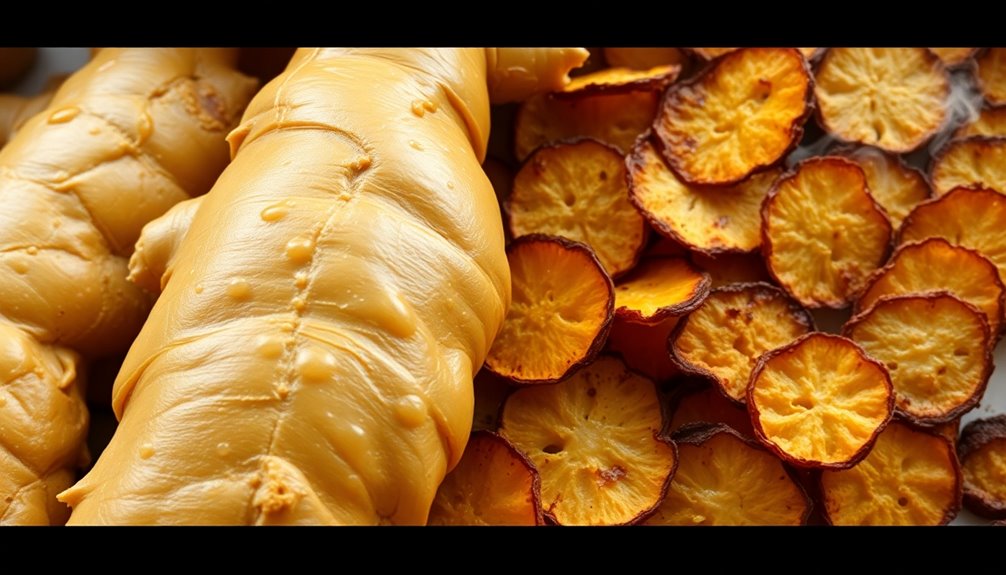
When ginger undergoes drying or slight heating, it experiences significant chemical changes that transform its flavor profile. The dehydration of gingerol creates shogaols, which are about twice as spicy as gingerol.
As a result, dried ginger packs a stronger pungency than its fresh counterpart, thanks to enhanced flavor intensity from chemical reactions during the drying process.
When you heat fresh ginger, its pungent taste softens, converting gingerol into zingerone, which produces a sweeter aroma.
These transformations through drying and heating not only intensify ginger's flavor but also make it adaptable for various culinary uses.
You'll find that both sweet and savory dishes benefit from these altered flavors, showcasing ginger's versatility in your kitchen.
Versatility in Recipes
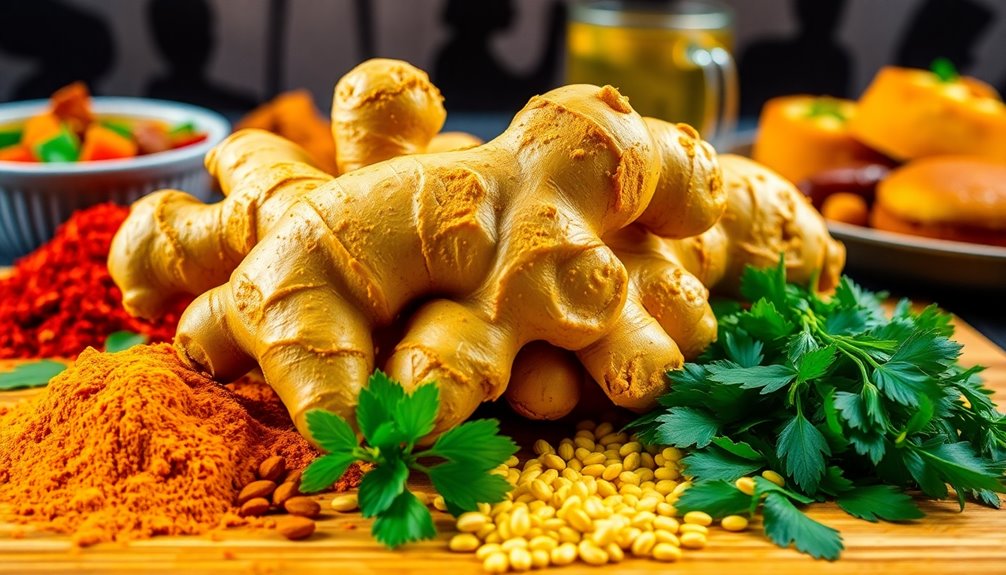
Ginger's versatility shines through in countless recipes, making it an essential ingredient in both sweet and savory dishes. You can easily incorporate ginger into your cooking with these ideas:
- Curries: Combine ginger with garlic and scallions for a robust flavor.
- Stir-fries: Add fresh ginger for a spicy kick alongside your favorite vegetables.
- Baked Goods: Use dried ginger in recipes like gingerbread cookies for a warm sweetness.
- Beverages: Brew ginger tea or mix ginger beer for an invigorating drink.
Whether you're marinating meats or blending spices, ginger adapts beautifully, transforming flavors and enhancing dishes. Its ability to shift from pungent to sweet makes it an invaluable ally in your kitchen. Additionally, using coarsely ground coffee can be beneficial when making a flavorful ginger-infused brew.
Frequently Asked Questions
What Are Aromatic Spices?
Aromatic spices are those that pack a punch in flavor and fragrance, enhancing your dishes markedly.
When you cook with spices like garlic, cinnamon, or cardamom, you're elevating the overall sensory experience of your meals. These spices release their delightful aromas when heated or ground, making them essential in various cuisines.
Plus, many have health benefits, adding even more value to your culinary creations. You'll definitely want to keep them in your pantry!
What Is Considered an Aromatic?
When you think about what's considered an aromatic, you might picture ingredients that boost flavor and aroma in your dishes. Common aromatics include onions, garlic, carrots, and celery, often sautéed at the start of cooking to release their rich flavors.
You'll find that combining these ingredients in threes, like the French mirepoix or the Asian trinity, enhances your meals considerably. Their absence can leave your dish tasting flat, so don't skip them!
Is Ginger an Herb or Spice?
You might wonder whether ginger is an herb or a spice.
Ginger is classified as a spice because it comes from the rhizome, or underground stem, of the plant. Unlike herbs, which typically come from the leaves, ginger's strong flavor and aroma are derived from its unique composition.
You'll find it enhances a wide range of dishes, especially in Asian cuisine, making it a popular choice in cooking and baking.
What Makes a Vegetable an Aromatic?
A vegetable's aromatic quality comes from its volatile compounds that release strong fragrances when cooked.
You'll notice these compounds enhance the flavors of your dishes. Aromatics usually contain high concentrations of essential oils, giving them their distinctive scents.
When you sauté or sweat these vegetables in fat, their flavors become more pronounced, adding depth to stocks, sauces, and soups.
Using aromatics in combinations can create a beautiful balance in your cooking.
Conclusion
In the world of spices, ginger stands as a vibrant muse, much like a painter's brush bringing life to a canvas. Its aromatic qualities awaken your senses, inviting you to explore both sweet and savory dishes. From the warmth of a cozy ginger tea to the zing in your favorite stir-fry, ginger transforms every meal into a culinary adventure. So next time you reach for this golden root, remember its rich tapestry of flavors and health benefits waiting to unfold.


